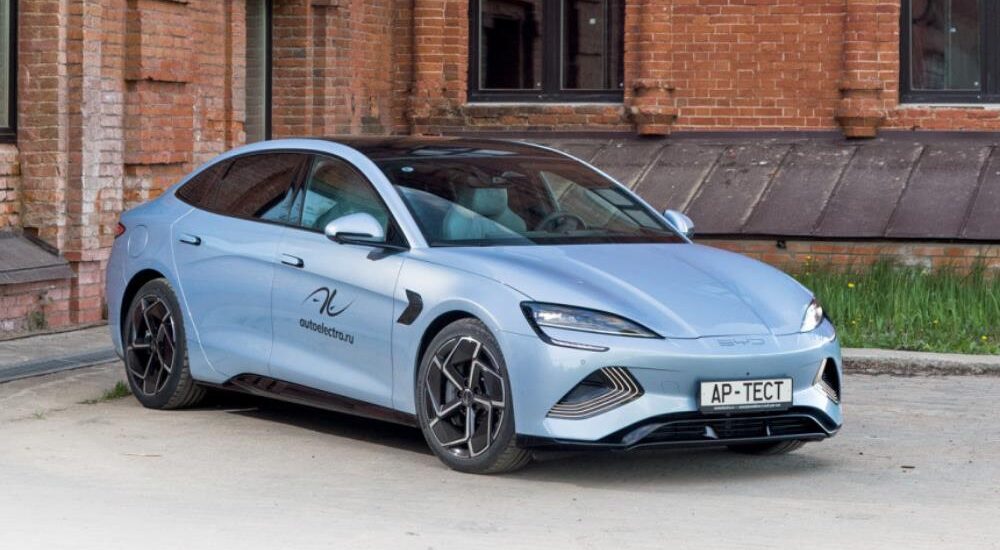On a full battery charge with a capacity of 82.5 kWh, the BYD Seal electric sedan promises to travel an impressive 650 km. And on the trunk lid among the characters, the number 3.8 stands out — which is none other than the acceleration time to 100 km/h. Is the Chinese “seal” really that cool?
I swear, this is the most beautiful Chinese car I’ve ever had the pleasure of driving. Bravo, Wolfgang Egger! Yes, that’s the same Egger who had the chance to work at both Alfa Romeo and VW Group, and since 2017 has been leading the designers at BYD.

The concentric sections of the DRLs are striking, and the BYD emblem lights up for a few seconds only when the locks are activated.
Just take a closer look at these “Faraday lines” at the corners of the front bumper — they evoke associations with both magnetic fields of induction, as they are usually depicted in physics textbooks, and patterns of seashells. The rear lights, filled with “pixels” of LEDs, are also mesmerizing. One might assume that the Seal is merely a design modification of the BYD Han EV sedan that we are already familiar with, especially since they have the same wheelbase — 2920 mm. However, while the Han is built on the DM3 platform, which also allows for a hybrid version, the Seal is an uncompromising electric car with a new, 800-volt e-platform 3.0 architecture and a more complex suspension system. For example, at the rear, there is a sophisticated kinematics with five arms for each wheel.
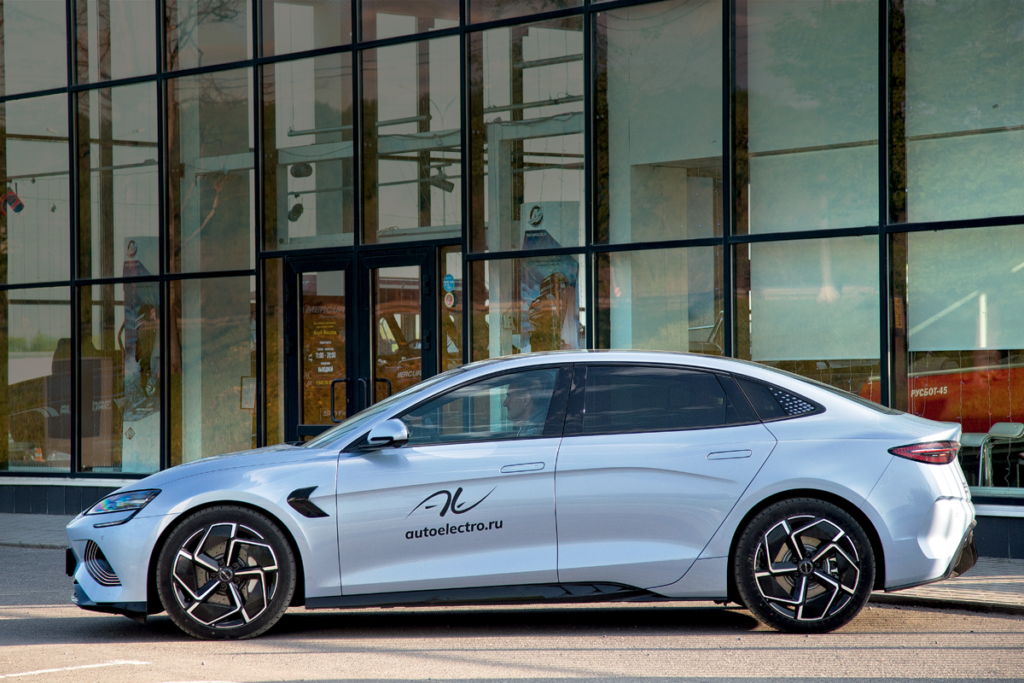
The silhouette is magnificent, but the ground clearance is risky. Even without a load, there’s 130 mm under the chassis, and the plastic spoilers in front of the wheels hang 92 mm above the ground.
But the main feature of the construction is the lithium iron phosphate Blade series battery with flat power elements in a sturdy case. This is integrated into the body’s power structure — this is the so-called CTB (cell to body) architecture. Actually, Tesla is also transitioning to a similar scheme for its Model 3 and Model Y, for which an integrated battery has been developed with larger 4680 standard cells instead of the previous 2170. This contributes to active safety by lowering the center of gravity and passive safety — the Seal has earned the maximum five stars in the C-NCAP series of Chinese crash tests.
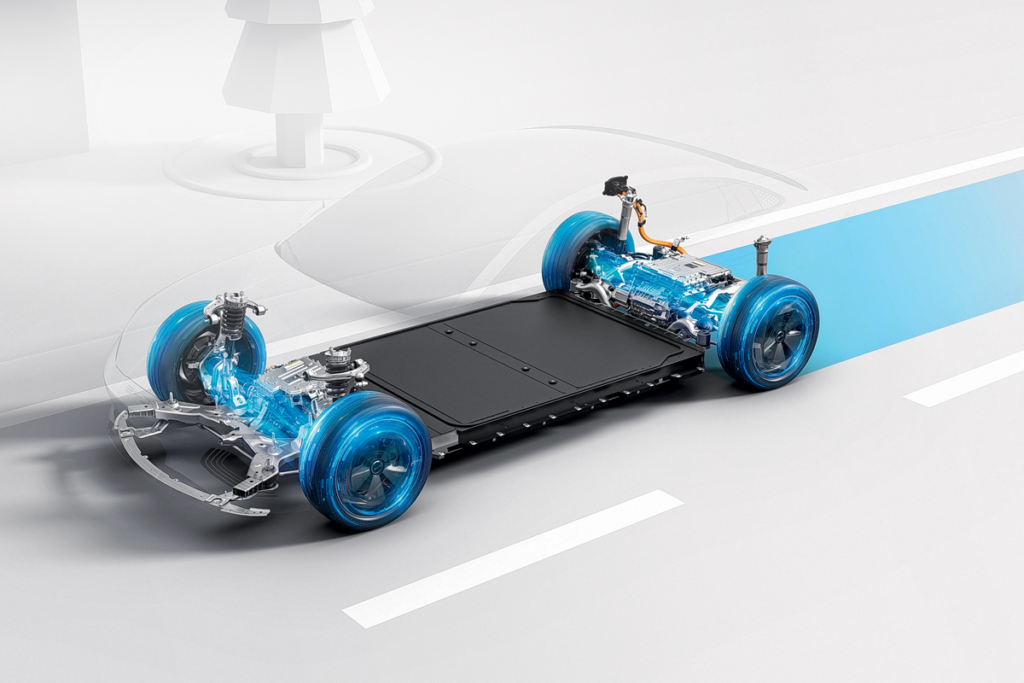
The cell-to-body layout — the battery in a sturdy case is integrated into the body’s power structure, which results in an impressive torsional rigidity of 40,500 Nm/degree.
Additionally, this construction allowed for lowering the seats by 10 mm, but even after this, there is no sensation of a low racing position behind the wheel. The battery has its thickness, which cannot be ignored: even with the seat lowered to the bottom, I can see the hood. From the perspective of visibility, this is even a plus. The seat itself, with an integrated headrest, is universal — the semi-circular backrest holds quite well in turns, but does not impose stiff side support bolsters. Both front seats have electric drives, full-fledged heating, and ventilation, including the backrest.
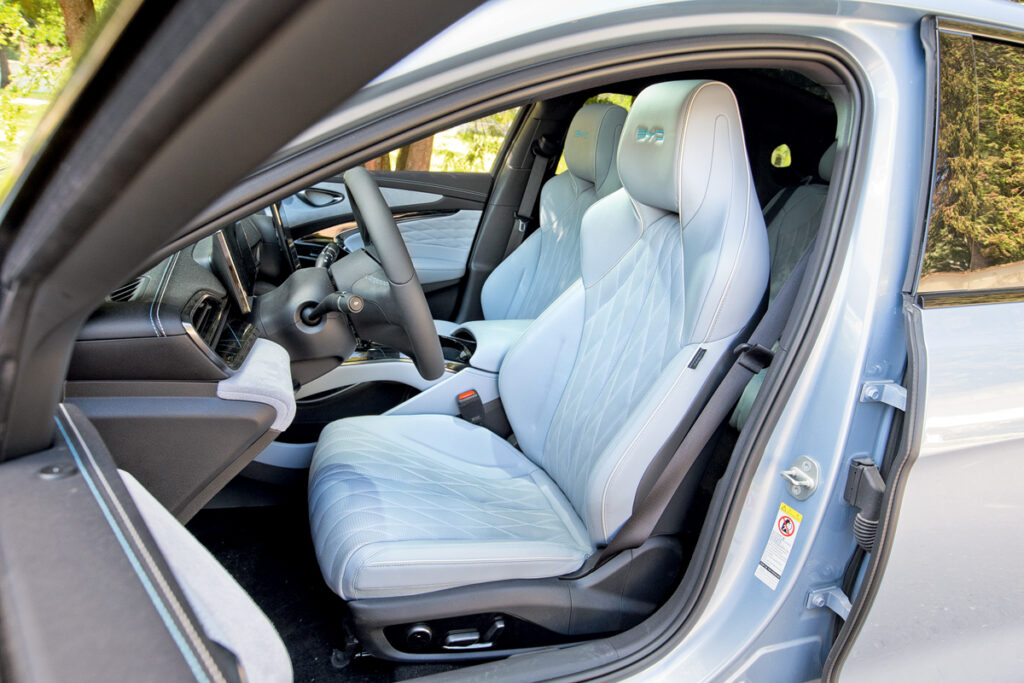
The anatomically-designed seat is unobtrusively comfortable, with electric adjustments for the angle of the seat cushion and lumbar support.
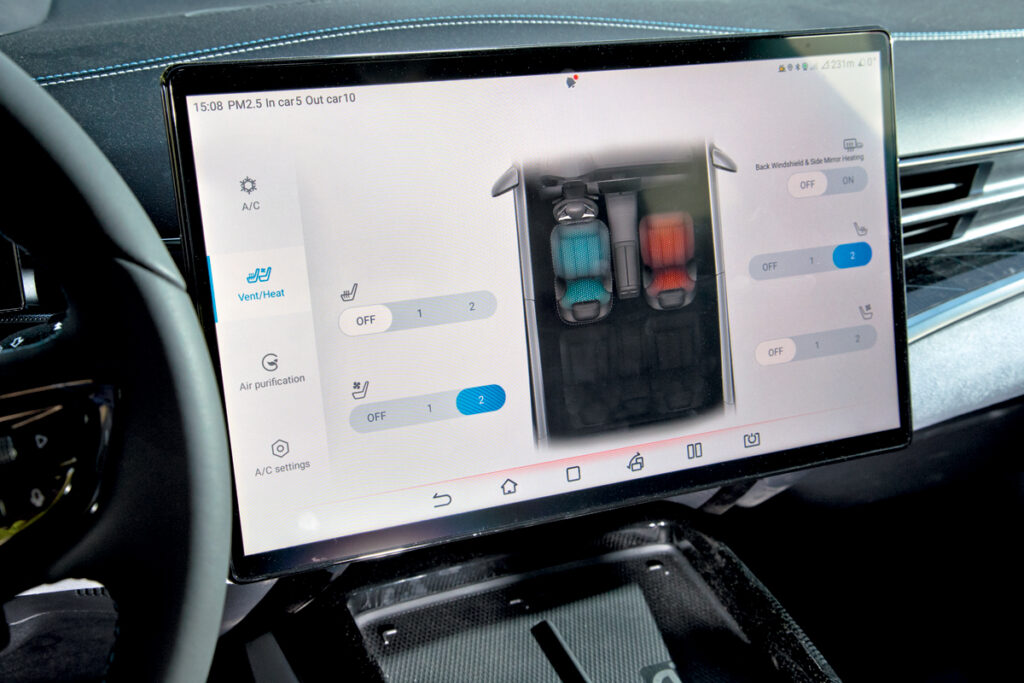
Heating and ventilation, which can be enabled through the menu, cover the entire area of the front seats.
The steering wheel has mechanical adjustments and a pleasingly chunky rim with a very neat flat seam of leather trim. The instruments, of course, are fully digital, but the design options are limited – only two. However, the top version has a head-up display. And in the center of the panel, of course, is BYD’s “signature dish” – a huge swiveling “TV” with a 15.6-inch diagonal. Plus, there’s excellent graphics and an Android operating system, allowing for easy installation of up-to-date Russian applications.
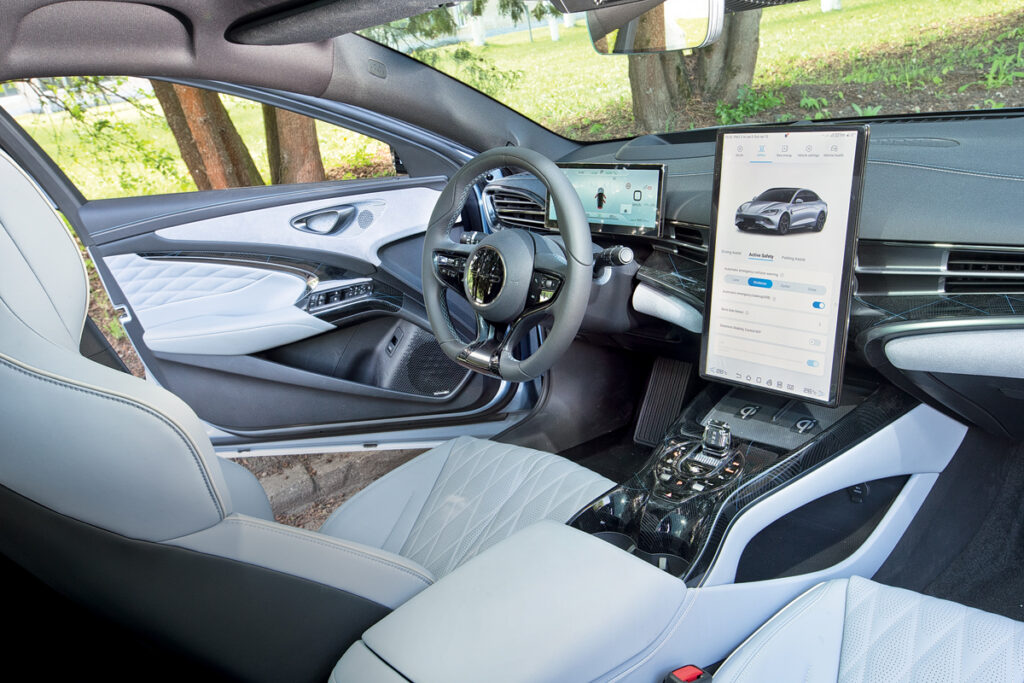
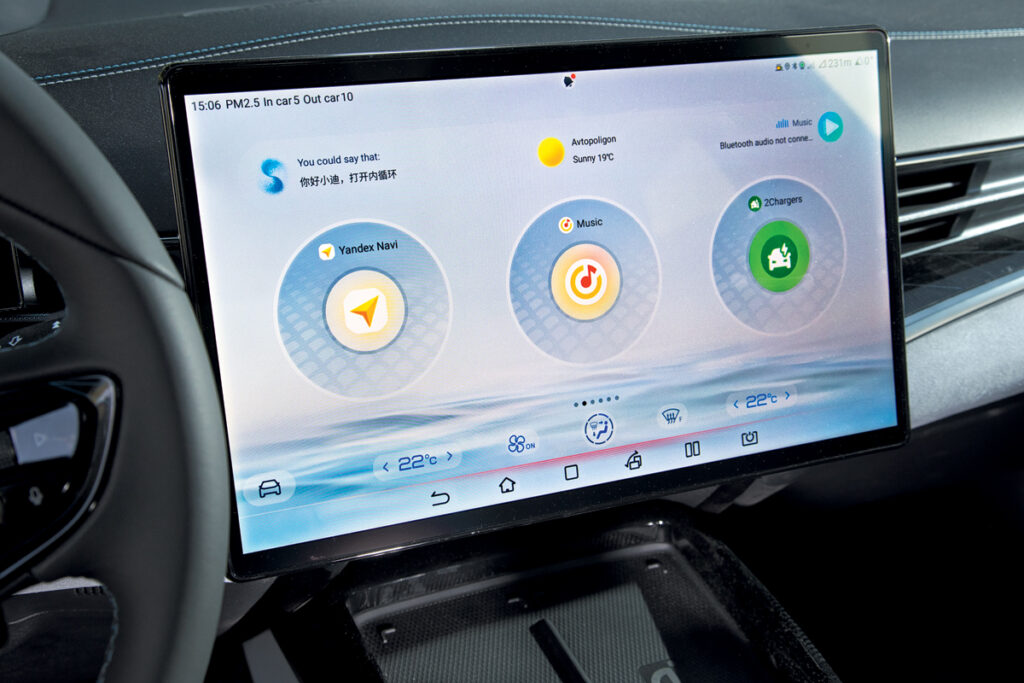
In the center of the front panel is a 15.6-inch swivel display, and below it are two induction charging pads for smartphones
And fully electronic control of the dual-zone climate control. The artfully integrated vents in the front panel do not have any knobs – their position can only be changed through the menu. For example, in Avoid mode, the vents will raise the air stream to the ceiling, while Facing mode directs it towards your face. I liked the Swing mode the most – in this mode, the vents, like in domestic split systems, smoothly change the direction of airflow in an automatic cycle.
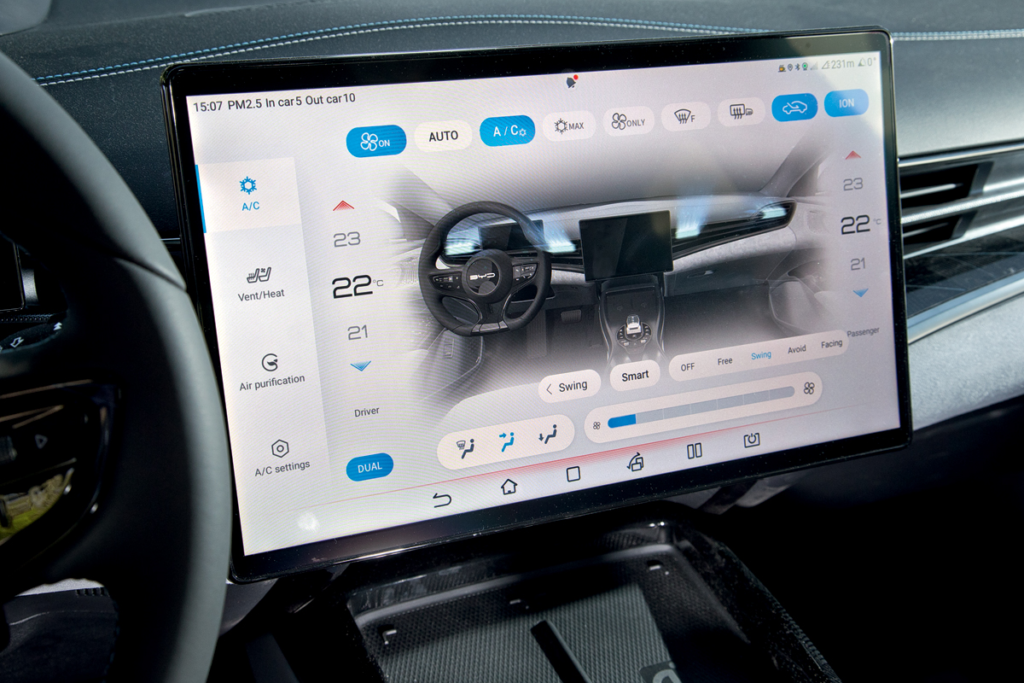
Сlimate control management is through the menu. You can set each vent individually or choose one of the automatic programs.
Unfortunately, among the hotkeys for climate control, there is no recirculation activation. By the time you navigate through the menu and select the appropriate icon, you would have already breathed in impurities. An auto recirculation mode would solve this, but instead, the menu only has an automatic activation of the PM2.5 fine particle filter.
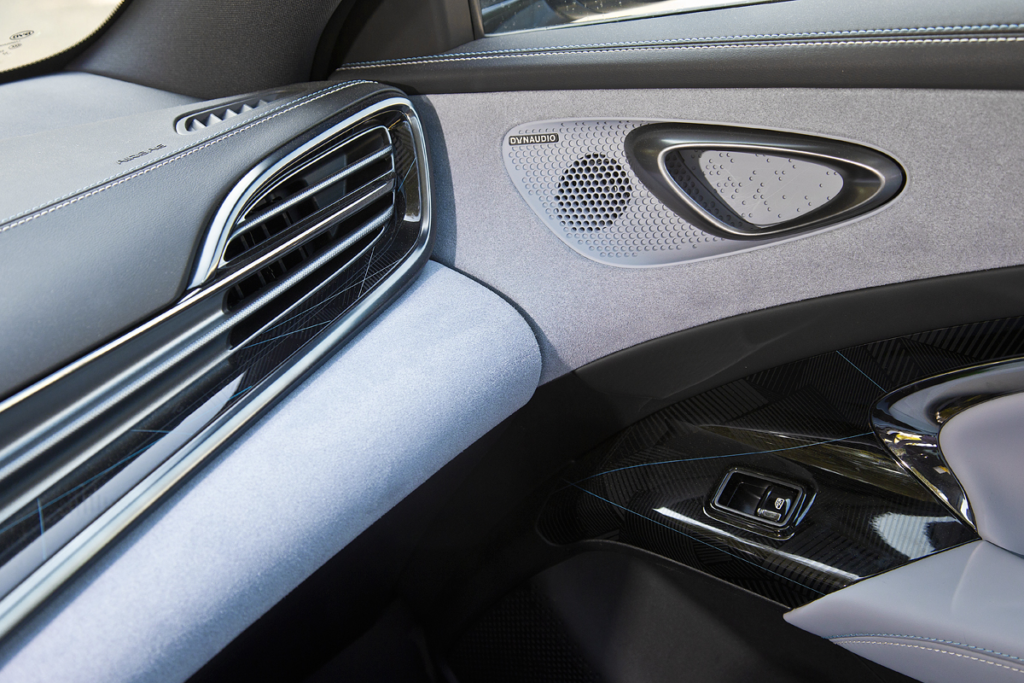
As for the cabin finish, there are no complaints – soft plastics, genuine or artificial leather are everywhere, and there are inserts of blue Alcantara on the front panel and doors. Even the small details are handled with German meticulousness: rubber liners in the door handle recesses, in the cup holders, and USB ports (both USB-A and USB-C are available) with contour lighting.
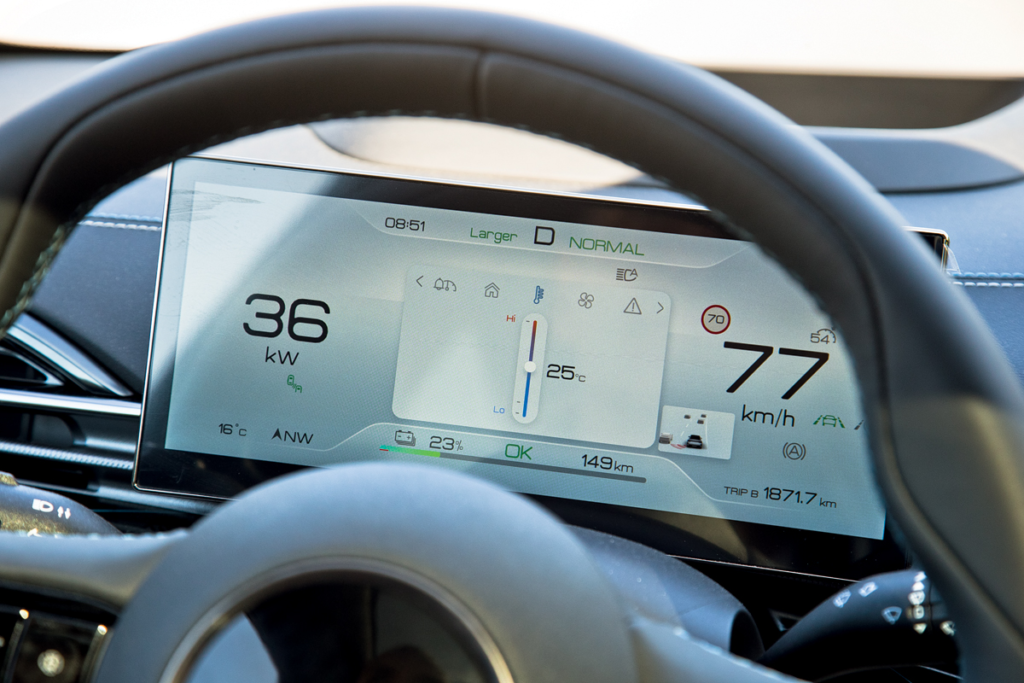
Different setting widgets can be displayed on the instrument cluster screen – including temperature, which can then be adjusted using buttons on the steering wheel.
What’s most delightful in the back seats is the clear sky overhead: the panoramic roof extends almost to the rear window. There is also ample legroom here – I’m sitting “behind myself” with an eight-centimeter gap. However, I didn’t find any multimedia delights in the armrest, like in the Han – only cupholders. But the Seal is designed like that – it’s more of a driver’s car than for passengers. And that means, it’s time to hit the start!
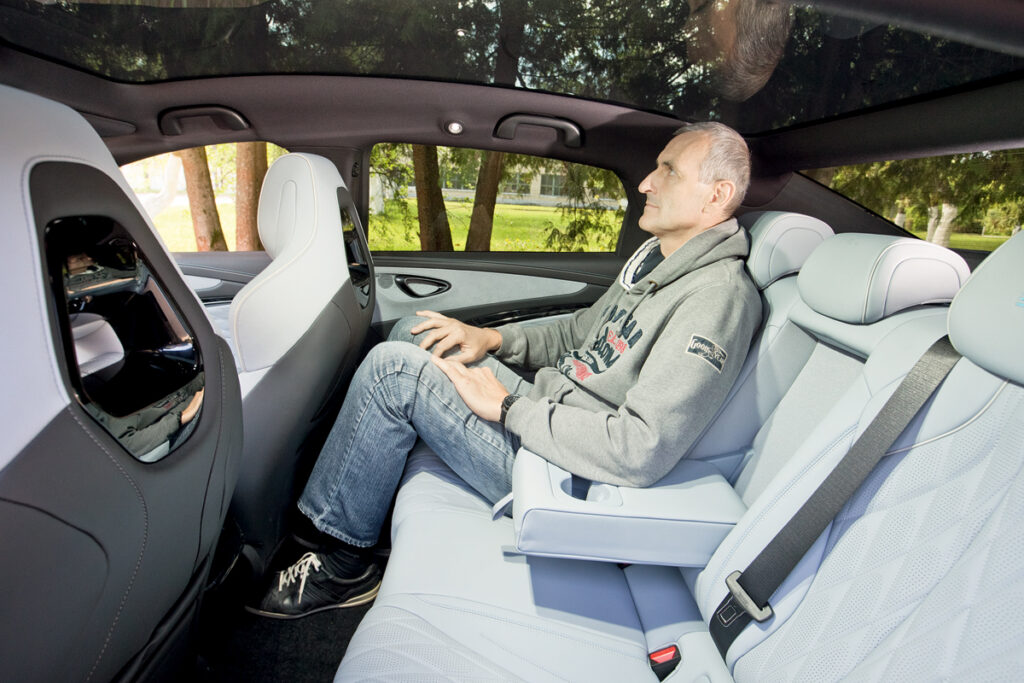
There is a lot of knee room, but if the front seat is lowered all the way down, there is nowhere to put your feet.
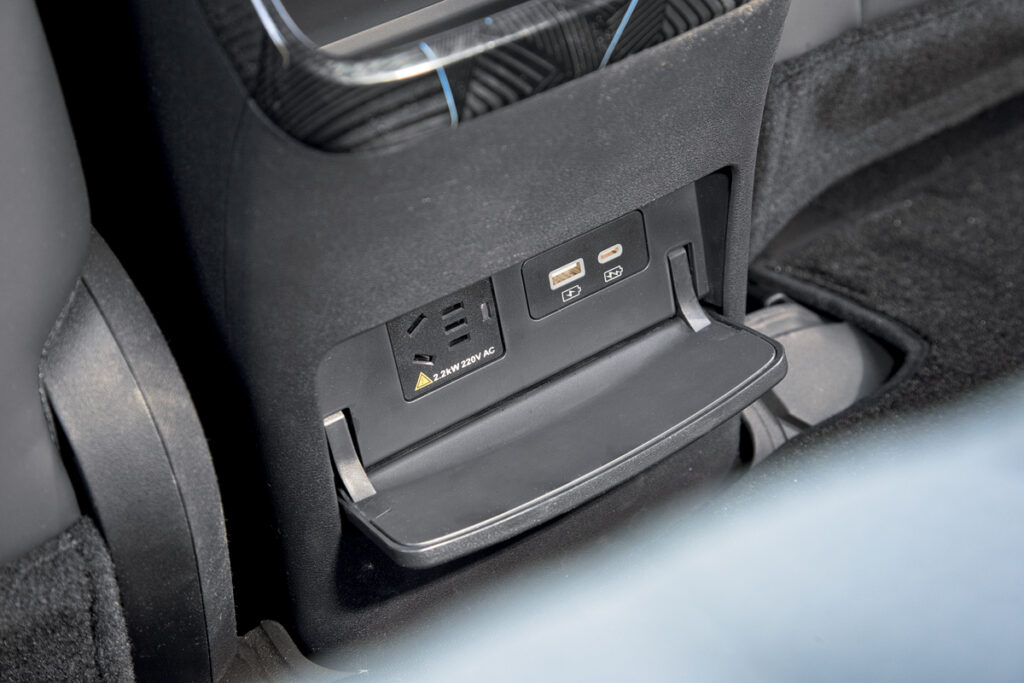
In the center of the front panel is a 15.6-inch swivel display, and below it are two induction charging pads for smartphones.
To engage “drive” mode, you need to give the “crystal” flag selector a short tug – and you can begin a silent acceleration. I am already prepared for the fact that BYD cars are finely tuned in terms of throttle control. There are no jerks, everything is smooth, but very forceful.

The “crystal” selector joystick works without delay. The semicircular button at the bottom is the inclusion of the “ignition”. Remote key start is also provided, which allows you to warm up the interior before the trip.
Acceleration to 62 mph (100 km/h)? The onboard telemetry shows the promised 3.8 seconds, however, our GPS measuring device VBox is more realistic: 4.13 seconds. The BYD Han also similarly “rounded up” the results. But that’s forgivable. What’s worse is that such a result could not be achieved on repeated accelerations: on the third, fourth attempt, the rate of speed gain after 50 mph (80 km/h) decreased, and the time increased to almost five seconds. The battery charge couldn’t have affected it: there was more than 80% of electricity in the “tank.” So, most likely, the electronics are limiting the power according to some algorithms – possibly taking into account the temperature of the battery or inverters. Though, the outside temperature was an ideal 66.2°F (+19°C) for the measurements.
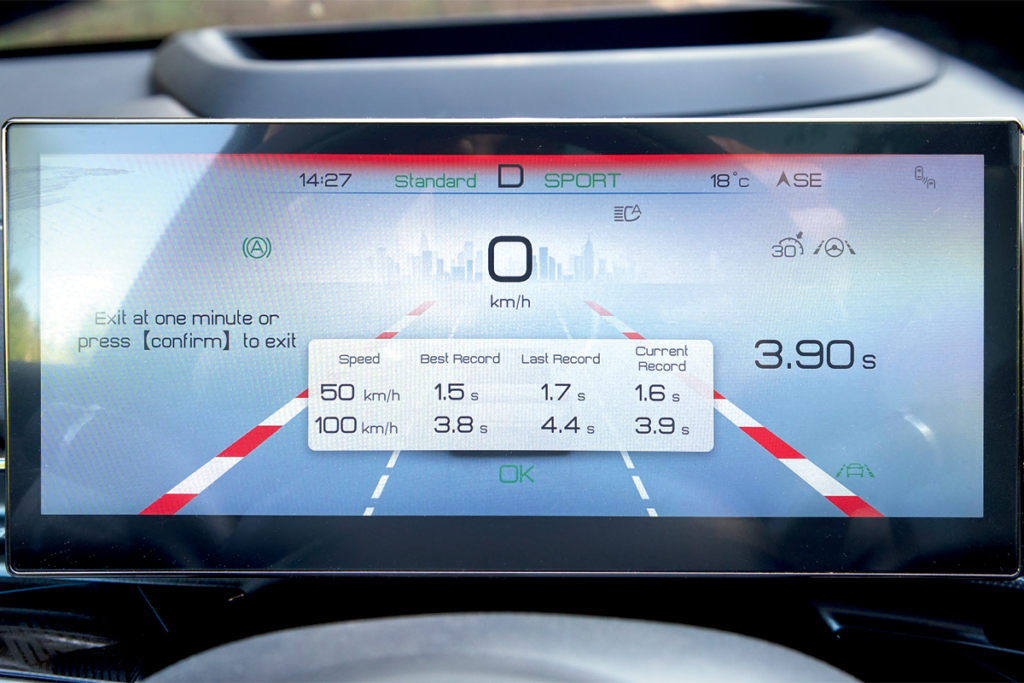
In Sport mode, you need to hold the button on the steering wheel, and the acceleration telemetry mode will appear on the instrument panel: 3.8 seconds on the screen is 4.13 seconds in reality.
We took a break, drove in standard modes, repeated the acceleration – it didn’t help. 0 to 62 mph (100 km/h) in 4.73 seconds. This is not a Porsche Taycan 4S, which reaches 62 mph (100 km/h) in the same 4.1 seconds, but five times in a row, and then easily accelerates up to 155 mph (250 km/h). But for the BYD Seal even 124 mph (200 km/h) is unattainable: there is plenty of power (530 hp from two electric motors combined!), but the electronic “limiter” cuts off acceleration at 118 mph (190 km/h).
By the way, the brakes are all good here: the heavy electric car stops from 62 mph (100 km/h) in 117.8 feet (35.9 meters). And from 93 mph (150 km/h) in 265.7 feet (81 meters). Credit should also be given to the latest Continental SportContact 7 tires with a size of 235/45 R19.
Some measurement results:
Acceleration time
| Speed | Time |
|---|---|
| 0—50 km/h | 1,8 s |
| 0—100 km/h | 4,1 s |
| 0—150 km/h | 8,7 s |
| 60—100 km/h (D) | 1,9 s |
| 80—120 km/h (D) | 2,6 s |
| Max speed – 190 km/h |
Braking distances
| From | Distance | Deceleration |
|---|---|---|
| 100 km/h (62 mph) | 35,9 m(117.8 ft) | 10,7 m/s² |
| 150 km/h (93 mph) | 81,0 m (265.7 ft) | 10,7 m/s² |
However, the sporty ambitions end at braking: the BYD Seal is far from being a Porsche in terms of handling. And not even a Volkswagen.
You would think that with such a low center of gravity, almost perfect weight distribution, and a sophisticated rear suspension, the Seal should stick to the asphalt in corners. But when driving at a faster pace, you can feel the heaviness, body roll – and, most importantly, in most turns, you have to adjust the steering to correct the trajectory. It’s hard to gauge the angle at the entry of a turn and go through the entire curve without additional steering adjustments: under load, the electric vehicle transitions to a tighter radius, and you have to unwind the steering. There is also a lack of responsive handling.

On the overhead console is a typical BYD light and sunroof touch control unit, which Seal does not have.
There is also a “tracking” camera for the rear passengers.
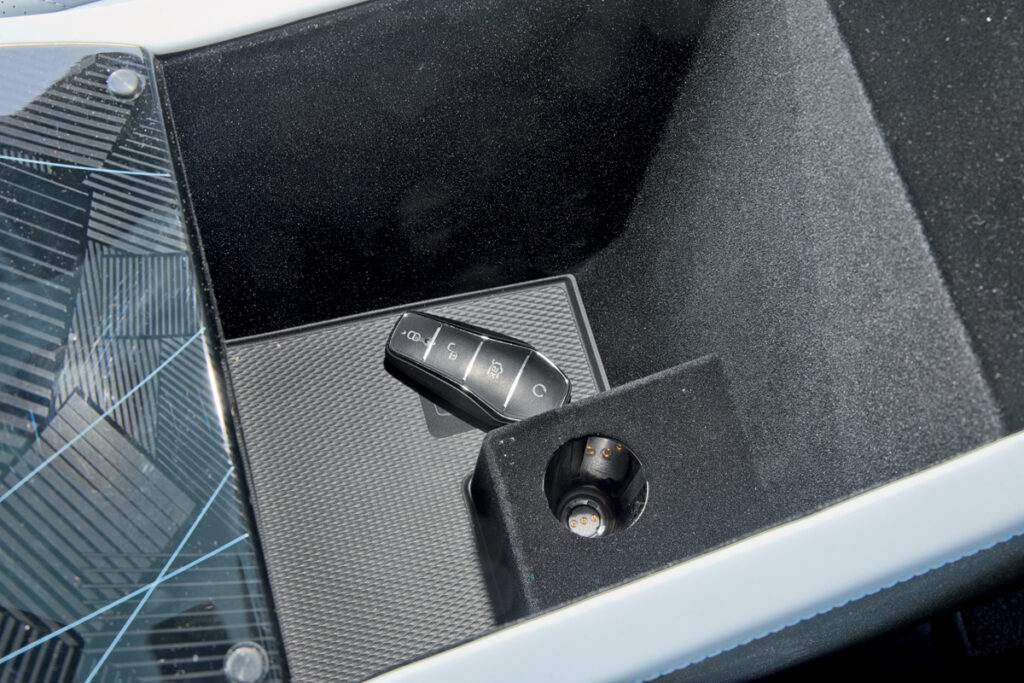
In the armrest box there is a socket for charging… a karaoke microphone!
However, all these flaws are only noticeable during aggressive driving – in standard modes, the handling is quite reasonable. And on a straight road, there is no feeling of excessive sharpness. Add to this the excellent ride smoothness – the Seal handles small bumps very well, and at high speed, it even slightly sways. Plus, outstanding noise insulation (the front doors have double glazing). And you will understand that the Seal is not created for racing, but for a relaxed driving experience. And this is the right approach. After all, primarily electric vehicle owners drive in eco mode, extending the battery charge and using the potential of the motors barely a third of the way. If you aggressively press the accelerator, the Seal consumes a whopping 37.4 kWh per 62 miles (100 km)!

The exterior mirrors are not the largest, and the eyelet on the left pillar is a driver monitoring camera, which can be covered with a shutter.
What about standard modes? With one passenger and a fully charged battery, instead of the promised 404 miles (650 km), the Seal managed to travel… 242 miles (390 km). Moreover, for the last 9 miles (15 km), BYD limited the power: even with the pedal floored, the output did not exceed 16 kW according to the wattmeter, and the speed – 43 miles per hour (70 km/h). The algorithm for reaching the destination is the same as on the BYD Yuan Plus crossover.

On the large display, there is a high-quality picture from the surround-view cameras with angle selection.
On the positive side, after completely depleting the battery, the Seal started charging from a fast DC terminal without any issues. Fortunately, there is now such a terminal at Dmitrovskoye proving ground, equipped with a GB/T connector, which is compatible with Chinese electric vehicles. The station can output up to 120 kW, and the car’s onboard network is capable of accepting as much as 150 kW, but during charging, the power fluctuated around 82-88 kW, which is not bad. At the end of the “refueling”, the figures on the display began to decrease: first to 40, then to 20 kW – in the end, charging the battery from 0 to 100% took 1 hour and 10 minutes.
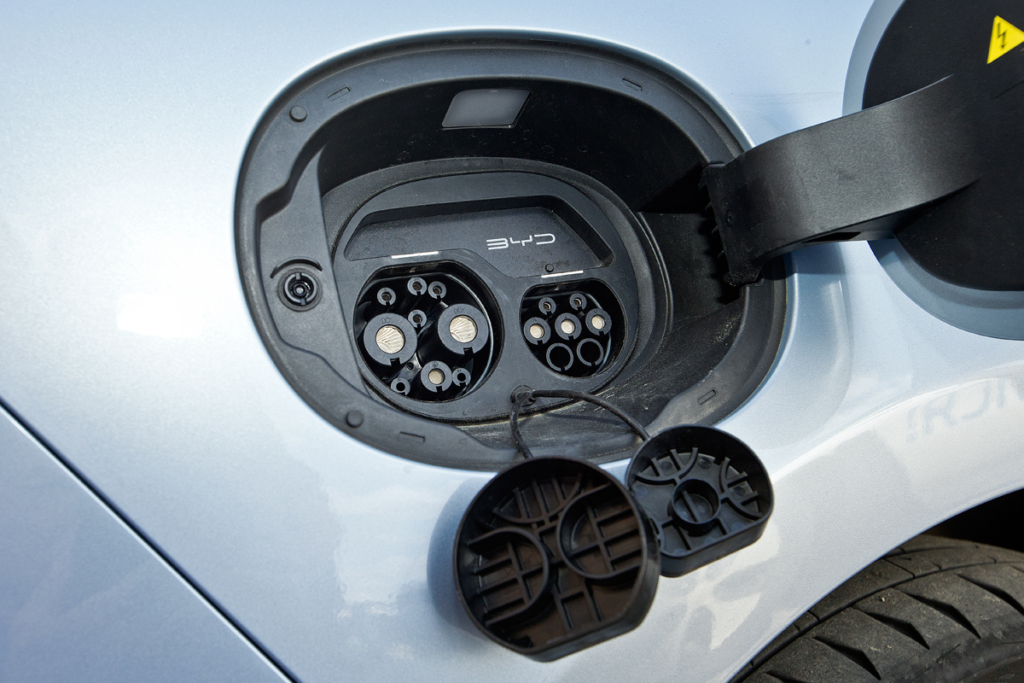
I also tried charging using AC power terminal. Everything works, but the Seal, like other Chinese electric cars, uses only one phase out of three, so the charging power is no more than 7 kW.

The hood is on gas struts, and beneath it, there’s an additional frunk (front trunk) with a volume of 53 liters.
In conclusion, considering the price – as this all-wheel-drive top-spec version costs 5.3 million rubles at Autoelectro, the company that provided us the car for testing – it’s an interesting alternative to the Tesla. And the lack of official sales even plays in its favor: the BYD Seal will remain exclusive in the foreseeable future, not at risk of being seen in every neighborhood within a year.
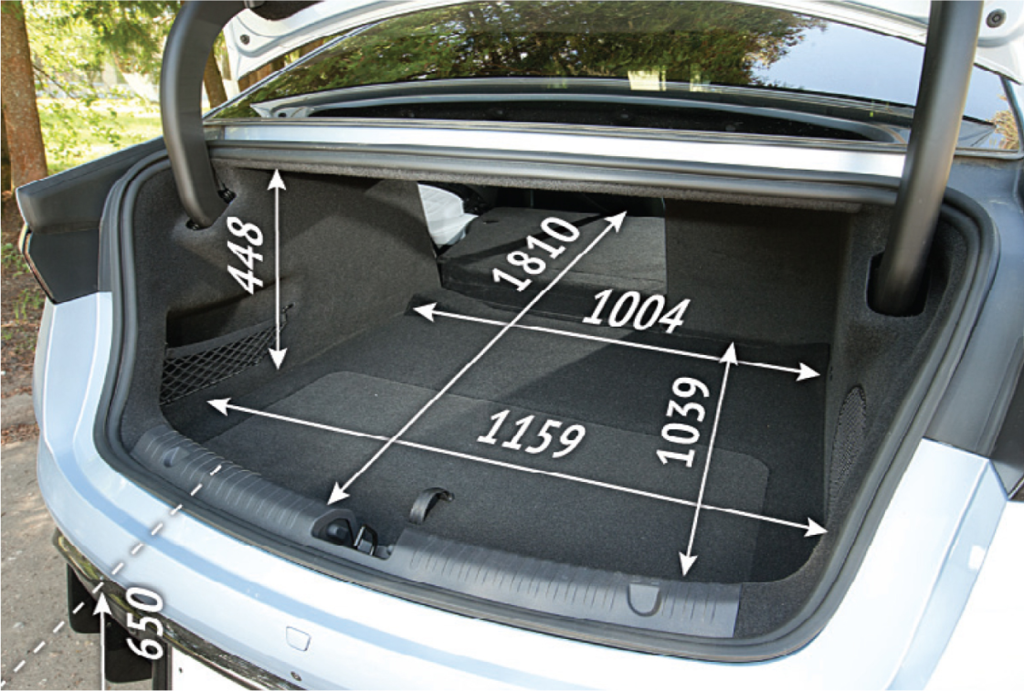
The main trunk is not very large, but it has a subfloor and a “sub-subfloor” with tools and tire sealant instead of a spare tire (Dimensions are in millimeters).
Buying a car without an official warranty is, of course, concerning. But Autoelectro is ready to supply spare parts within a month. For example, the front bumper skirt was damaged during transport on the test car (not surprising – given the overhang and a ground clearance of 130 mm). But the part has already been ordered and will soon be in Moscow.

The rear diffuser contributes to reducing the drag coefficient to an outstanding 0.219.
In China, the Seal comes with a warranty of six years or 150,000 kilometers. By the way, the basic rear-wheel-drive version with 204 hp costs there 189,800 yuan (about 2.2 million rubles) – 18% cheaper than a comparable Tesla Model 3. The dual-motor all-wheel-drive Seal with 530 hp costs 279,800 yuan, 16% cheaper. This is the result of the price wars that Sergey Znaemsky talked about: after Tesla engaged in price undercutting, BYD made a counter-move. After all, in the first quarter of this year, 42,782 Tesla Model 3 sedans were sold in China, whereas 19,573 buyers chose the BYD Seal.
Dimensions, weight and weight distribution along the axes

Actual vehicle weight without driver – 2207 kg.
Manufacturers’ data are highlighted in blue/Autoreview measurements are highlighted in black. Dimensions are in millimeters.
**Interior width at shoulder level in the first/second row of seats.
Photo by Dmitry Pitersky
Expert group: Andrey Mokhov
This is a translation. You ca read the original article here: BYD Seal и 530 сил: наш тест и замеры на полигоне

Published July 12, 2023 • 23m to read

